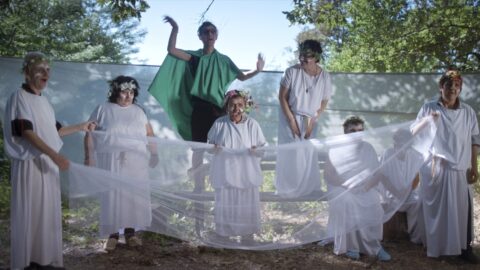The arboreal vistas of the Strandzha Mountains are imbued with porous, polysemous mystery in Pepa Hristova’s eponymous documentary. The liminal significance of the woods straddling the border between Bulgaria and Turkey transcend geographic boundaries to evoke historic binaries between past and present. Oscillating between the oneiric and the banal, Hirstova’s imagery implies that these myriad tensions produce a conception of cultural identity which subsequently informs a sense of difference and, ultimately, sociopolitical power.
The film cascades between various enclaves, including a commune of intellectually disabled women and a cadre of wayward teenage boys. Both groups share a strain of performativity: the women roleplay as Samodivas1fairies in Bulgarian folklore in a theatrical project while the boys traipse through abandoned barracks pretending to be soldiers. The latter remark on the Syrian refugees, dead and alive, they’ve seen in the forest. Their words echo the recollections of a soldier who killed refugees fleeing the Eastern bloc via Bulgaria during the Soviet era, incentivised by the promise of extended leave for every refugee killed, and who now whiles away the present robbing Syrian refugees.
While there’s an unmistakable aura of grim portent threading throughout Strandzha (2025), the film’s evocation of the past gestures towards regenerative properties borne by communal rituals. Archival and contemporary footage of processions invite comparisons to ethnography. Nowhere is this more explicit than in the enigmatic hermit who performs on a woodwind, evincing explicit parallels to Pan. These passages, though striking in isolation, are indicative of Hristova’s expansive ambition almost yielding mere iterations, rather than developments, of her core thematic preoccupations.
Then again, Strandzha is a film predominantly concerned with the subtle differences between rhyming visions and sounds of the natural world made uncanny. Nocturnal negative exposure photography recurs briefly but memorably as a tool of luminescent magnification that exudes an aura of ill portent yet evades pat categorisation. Sounds like burbling water and women’s laughter also gain gradual significance as aural indications of renewal and resilience. Hristova’s filmmaking is most confident and entrancing when she suspends the viewer in an aura of ambivalent mystery.
The film’s mysticism vies for equal footing with its urgent nods to changing geopolitics in Europe. That uneasy marriage enlivens Strandzha with a poignant beauty that does more than merely aestheticise its verdant backdrops. “In this place,” one subject remarks, “the abundance is not yours alone but that of all ancestors who have achieved wisdom.” It’s the pursuit of that wisdom within the ineffable which gives Hristova’s film its humbling, hypnotic resonance.
Nick Kouhi is a programmer and critic based in Minneapolis, Minnesota

